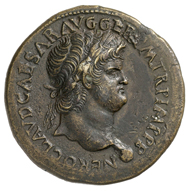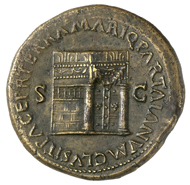with the kind permission of the MoneyMuseum, Zurich.
Why is it that for centuries – or rather thousands of years – the head has served as the motif for the side of a coin? And why has this changed in the last 200 years? This chapter of the series ‘Human Faces’ looks at Nero and the closing of the gates of the Temple of Janus.
Head of Nero, after 64 AD. Glyptothek, Munich.
In the summer of the year 66, the citizens of Rome witnessed a great spectacle: Tiridates, the brother of the King of the Parthians, threw himself at the feet of the Roman Emperor Nero to receive from him the diadem of rule over Armenia. And with that, Nero had achieved what the greatest commanders of the Republic had been unable to: he had negotiated peace with the Parthians. Only Augustus had managed to do anything vaguely similar. How was it possible that, of all people, this artist on the imperial throne had somehow become the ‘Parthian charmer?’
This historic moment was preceded by several less-than-glorious military actions by the Roman legions in Armenia. The frequent change of supreme commander, enforced as per Nero’s growing distrust of successful generals, had made sustained warfare impossible. It was, in fact, the Parthians who controlled the disputed buffer state, but the Parthian king was a reasonable man. He knew very well that it would require a lot of effort to continue to fend off the Roman attacks. So it was up to him to come up with a lasting solution – he offered Nero a compromise. A member of the Parthian royal family, Tiridates, would rule in Armenia, but with Rome’s approval.
Roman Imperial Era. Nero (54-68). Sestertius, Lugdunum, around 65. Bust of Nero with laurel wreath facing right. Rev. Temple of Janus with closed gates, and around it the inscription (in translation) ‘Peace on land and at sea. He closed the door of Janus.’ © MoneyMuseum, Zurich.
For Nero, the Parthian’s request was a gift from the gods. Just shortly before, he had had to crush the Pisonian Conspiracy in which a whole host of high-ranking senators had been embroiled, and his image had suffered greatly. He desperately needed to do something to improve his reputation. And the Roman approval of the appointment of Tiridates could be staged as a great spectacle. Even the closing of the Temple of Janus was performed in resplendent fashion. With it, he was informing all Roman citizens of peace with the Parthians. He subsequently made this fact known throughout the entire Roman Empire by way of a coin face design.
And so Tiridates set off on his way. His voyage, which took nine months, is said to have eaten up 800,000 sesterces A DAY. The provinces had to raise a total of 216 million sesterces to finance the imperial propaganda act! But for Nero, it was worth it. Even his enemies confessed that Rome had never appeared as powerful as it did on the day that the Parthian humbly approached Nero. The internal political situation eased, and Nero could now do what he had always dreamed of: go to Greece, where he would compete against the best artists and be triumphant.
In the next chapter, you’ll get to know the first Roman Emperor to have been depicted on his coins with a magnificent full beard.
All sections of the series can be found here.
The book ‘MenschenGesichter’ is available in printed form from the Conzett Verlag website. It soon will be translated to English. …








